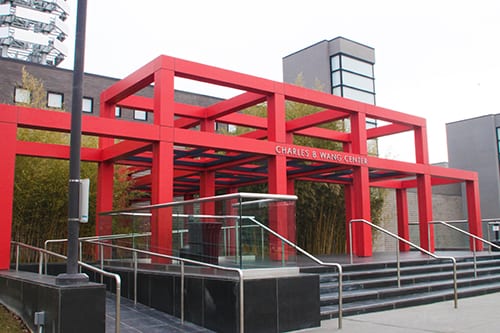
The Charles B. Wang Center at Stony Brook University has a new exhibit entitled “Forgotten Faces: Visual Representation of Trauma and Mass Killings in Asia” on display through Dec. 12 of this year.
This exhibit, curated by Jinyoung Jin, Director of Cultural Programs at the Wang Center, unveils pieces from artists Kim Hak, Kumi Yamashita, Federico Borella, Lim Ok-Sang, Noh Suntag, Choi Byungsoo, Jung Min-Gi, Lee Yunyop, Tenzing Rigdol, Tung Min-Chin and Joe Sacco. Each piece brings awareness to the devastation faced by Asian people during tragic wartimes.
Being the “foremost world-class center of Asian and Asian-American arts and culture,” the Charles B. Wang Center made “Forgotten Faces” available for viewing through a virtual exhibition. Through an online catalog, viewers can select artwork and read their descriptions at their own leisure. The zoom features allow for extreme attention to detail as viewers can move seamlessly along their screen between each piece, almost as if they were walking through the Wang Center in real time. Powered by exhibbit.com, the virtual exhibit allows for the display of unlimited artwork on any computer or mobile device.
The work curated by Jin calls for viewers to remember those who have suffered due to mass killings and genocides in Asian countries, which have been out of sight and out of mind for far too long. The photographs, paintings and sculptures in the exhibit spread “public awareness” of a largely ignored history of brutality and undertakes to answer how art can express dark histories and a desire for social justice.”
A wood sculpture by Tung Min-Chin entitled “The Birth of a New Hero II” displayed in the exhibition is representative of the mental and emotional toll taken on those who have lived through and experienced tragic events in Asian history. These events are rarely spoken of in the Western world. The wood carving displays a human figure that is covering their face with their hands as they sit on the ground in a crouched position. The form appears to be trapped within the wood in order to convey a feeling of entrapment and loneliness. A feeling that may have been familiar to those who experienced post traumatic stress and feelings of pain and helplessness, as violence was a common theme in the lives of Asian people.
Some examples of these periods of loss and destruction include Taiwan’s 2.28 massacre (1947), South Korea’s Jeju massacre (1948, the famine following China’s Great Leap Forward policy (1958–1962), the Bangladesh genocide (1971) and Cambodia’s killing fields (1975–1979).
Pieces like Min-Chin’s and others in the “Forgotten Faces” exhibition provide representation for moments in history that are sometimes forgotten, or unacknowledged by the Western world. While extensive research is done on the Holocaust and other European tragedies, it seems as the equally horrifying events that have occurred in other areas of the world are not as prevalent. By curating “Forgotten Faces”, Jin has exposed the art world to a source of learning and understanding, and “reveals the links between these crimes against humanity and works of art.”
“Forgotten Faces: Visual Representation of Trauma and Mass Killings in Asia” and other virtual art exhibitions can be viewed online, and at the Wang Center on the Stony Brook University campus.











